Who Does the Duties for Technology?
From Extravagance to Everyday – How Technology Went from Elitism to Everyday Utility
The Responsibility of Technology: Whose Job Is It, Really?
Technology doesn’t belong to one sector anymore. It’s not just the duty of Silicon Valley engineers, university labs, or corporate R&D teams. In today’s globalized world, technology is co-shaped by users, creators, policy-makers, and even people who may never have attended formal schooling.
Yes — you, the everyday phone user, the WhatsApp sharer, the village mechanic watching YouTube tutorials, the retired parent doing UPI transactions — you’re part of the cycle now.
The real question is: who ensures it’s accessible, meaningful, and usable by all?
The answer is everyone — but not equally.
From Industrial Extravagance to Everyday Tool
In the 1800s and early 1900s, during the first and second industrial revolutions, technology was exclusive — factory machines, power grids, and locomotives were visible symbols of national power, not personal tools.
A common man back then couldn’t afford or understand most tech. Electricity was for cities. Typewriters were for offices. Telephones belonged to officials.
Fast forward to the 2020s:
- Smartphones cost less than $100
- AI chatbots are free online
- Solar lamps power rural homes
- Drones deliver medicines in African villages
- Farmers track rain forecasts on weather apps
The gap between elite technology and people’s palms has collapsed — especially due to globalization, competitive manufacturing, and open-source development.
The Global Shift: Tech for All
Countries like China, India, and Kenya have become prime examples of how tech affordability meets mass adoption:
- India’s Jio revolution brought ultra-cheap 4G to millions — making rural villagers first-time internet users.
- Kenya’s M-Pesa turned mobile phones into digital wallets, decades ahead of Western adoption.
- China’s Shenzhen factories produce hardware so efficiently that even low-income users globally can access devices like Android phones, smartwatches, and mini projectors.
“In 1990, the average mobile phone cost $4,000. In 2025, a smartphone with better specs costs $50.”
— MIT Technology Review
Newsroom to Neighborhood: Stories of Change
Global newsrooms have tracked how this shift impacts real people:
- [BBC World Service] reports on Ethiopian shepherds using solar-powered smartphones to identify livestock disease.
- [Al Jazeera] covered Rohingya refugees accessing education through tablet classrooms in camps.
- [The Verge] documented Filipino fishermen using Google Maps to locate better catch zones.
Case Study: My Father, the Non-Schoolgoer Tech Pro
Let’s talk about something even closer — your father, a man who didn’t go to school, but now handles a 5G-enabled Android phone like a pro.
What makes this possible?
- Interface Simplicity
Android phones today offer voice typing, gesture navigation, regional language keyboards, and even AI-based call screening — reducing the need for tech literacy. - Preloaded Ecosystem
Phones now come with:- WhatsApp: to talk with children, share photos, and get news
- YouTube: a university for all ages — from learning recipes to fixing an old ceiling fan
- Google Lens: to translate shop boards or read aloud from medicine packs
- Digital banking apps: where a single fingerprint can handle monthly expenses
- Affordable Appliances Connected via Smartphone
- Using IR blaster apps to control the fan or TV
- Watching religious sermons live on YouTube
- Talking to relatives abroad via free video calls
- Tracking his blood pressure using connected smart devices
- Booking hospital visits through local healthcare apps
He doesn’t see himself as a “techie” — but he’s become a living example of democratized technology.
Technology’s New Duty: Inclusion, Not Just Innovation
It’s no longer enough to create gadgets — the duty of technology today is to ensure usability, affordability, and dignity for all.
And these duties fall on:
- Governments: to provide digital infrastructure and language access
- Developers: to make intuitive, inclusive applications
- Educators and NGOs: to teach digital skills without formal schooling barriers
- Users like us: to guide, support, and share with our parents, workers, and peers who might be just one click away from transformation
Final Thought: When the Common Man Becomes the Technocrat
The real revolution isn’t that billionaires build AI. It’s that a man who never entered a classroom now uses the same AI to talk to his grandchildren, pay bills, and run his household.
The roles have shifted. The common man no longer waits for permission to use tech.
He owns it. He shapes it.
And perhaps, unknowingly, he fulfills the duty of technology more honestly than the corporations that built it.
Further Reading:



